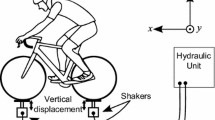Abstract
If a driver passes over a pedestrian lying on the road and flees, it is considered a crime. In several cases, even if the driver fled and was arrested, he/she often asserts that they did not know that the victim was a human being. However, the investigation agency often believes that a driver can certainly recognize when he/she passes over a person. Accordingly, such cases frequently lead to disputes due to the lack of criteria for recognizing when a driver was involved in run-over accidents. In this study, tests were conducted both to identify if drivers can recognize whether their vehicles passed over a person and to examine how they feel at the time. A silicon dummy, which was manufactured to have the same characteristic as the human chest, was used in this study. According to the method specified in ISO2631, the vibration delivered to the driver was measured, and eighteen participants drove a vehicle over the silicon dummy to experience how the vibrations felt. When the passenger car for the test ran over the dummy at speeds ranging from 10 km/h to 60 km/h, all participants recognized the delivered vibration, and the VDV that was delivered to the participants ranged from 1.81 m/s 1.75 to 2.38 m/s 1.75. The participants thought that the object they drove over was a stone or a piece of wood. This indicates that the driver certainly can recognize the vibrations generated from passing over a human chest even though it feels like a solid object.
Similar content being viewed by others
References
Article 54 of the Road Traffic Control Act (2011). The Legislation of the Republic of Korea.
Cheung, W. S. and Byeon, J. H. (2005). Measurement of whole-body vibration exposed from their UH60-helicopter analysis results. Trans. Korean Society for Noise and Vibration Engineering 15,12, 1327–1331.
Howarth, H. V. C. and Griffin, M. J. (1991). Subjective reaction to vertical mechanical shocks of various waveforms. J. Sound and Vibration 147,4, 395–408.
ISO 2631-1 (1997). Mechanical Vibration and Shock Evaluation of Human Exposure to Whole-body Vibration. International Organization for Standardization.
Kim, M. G., Yoo, W. S. and Kim, J. H. (2002). Evaluation of ride comfort considering seat and ride vibration modes. Trans. Korean Society of Automotive Engineers 10,4, 93–99.
Melvin, J. W. and Weber, K. Edn (1985). Review of Biomechanical Impact Response and Injury in the Automotive Environment. AATD Task B Final Report. UMTRI-85-3. The University of Michigan Transpotation Research Institute.
Melvin, J. W., Hess, R. L. and Weber, K. (1985). Thorax. Review of Biomechanical Impact Response and Injury in the Automotive Environment, 93–124. Task B Final Report. UMTRI-85-3. University of Michigan Transpotation Research Institute.
Milosavljevic, S., Bergman, F., Rehn, B. and Carman, A. B. (2010). All-terrain vehicle use in agriculture: Exposure to whole body vibration and mechanical shock. Applied Ergonomics, 41, 530–535.
Spang, K. (1997). Assessment of wole-body vibration containing single event shocks. Noise Control Engineering J. 45,1, 19–25.
Wikstrom, B. O., Kjellberg, A. and Dallner, M. (1991). Whole-body vibration: A comparision of different methods for the evaluation of mechanical shocks. Int. J. Industrial Ergonomics, 7, 41–52.
Author information
Authors and Affiliations
Corresponding author
Rights and permissions
About this article
Cite this article
Park, S.J., Chae, S.W. Driver recognition of a run-over accident. Int.J Automot. Technol. 13, 469–475 (2012). https://doi.org/10.1007/s12239-012-0044-1
Received:
Revised:
Accepted:
Published:
Issue Date:
DOI: https://doi.org/10.1007/s12239-012-0044-1




